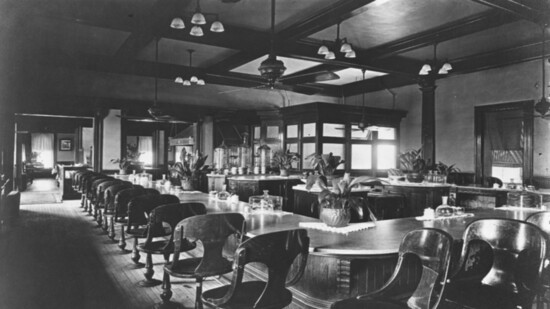A great deal of romance and nostalgia is wrapped up in the image of train travel. Topeka's railroad history was one of the reasons I fell in love with the city when I moved here almost 15 years ago. As a food writer, I was especially intrigued by Fred Harvey. He transformed dining for rail passengers with the creation of Harvey Houses, which were lunchrooms, restaurants and hotels that dotted the Atchison, Topeka and Santa Fe rail lines. His dining dynasty started here in the Capitol City.
In the early days of rail travel, there were no dining cars. Passengers had to bring their own food or eat at ramshackle eateries located at water stops, where the trains would restock their water and coal supplies along the route. These establishments were notorious for bad food, filthy conditions, and expensive prices. It was common for slow service to cause customers to abandon their paid-for meal (or never receive it!) or risk missing the train's departure.
Then, along came Fred Harvey. He opened his first lunchroom at the Santa Fe Depot in Topeka in 1876. In the following decades, Harvey House restaurants became known for delicious food, clean settings, and excellent service. Every table had white tablecloths, beautiful dinnerware, and a red rose as the centerpiece. Eventually, Harvey owned 65 restaurants, 60 dining cars, 12 large hotels, and all the restaurants and retail shops in five of the nation's largest stations.
In the early years, Harvey House servers were men. However, they were prone to altercations with customers, so Harvey decided to go with women servers instead. This was a controversial choice because being a waitress was considered one of the lowest professions for women, just slightly better than prostitution.
However, Harvey Girls were different. Advertisements for the job listed being of good character, attractive and intelligent as job requirements. The women, ages 18-30, signed a contract to work six, nine or twelve months, stating they would not wear makeup or jewelry and not marry for at least a year. They lived in a boarding house with a house mother and had an 11 p.m. curfew. The pay was good for the times, and since food, uniforms and housing were included, most women could save a nice nest egg or send the money home to help support their families.
Recently, Topeka City Lifestyle's editor, Kathy Graham, introduced me to the book Diary of a Waitress: The Not-So-Glamorous Life of a Harvey Girl by Carolyn Meyer. In it, we follow the journey of Katherine "Kitty" Evans from her family home in Leavenworth, Kansas, out west as a Harvey Girl. Her fictional story is in line with factual accounts of the real life of these women, from the job interview at Union Station in Kansas City to thirty days of training in a Kansas Harvey House (often in Topeka) and then moving on to locations in the West.
It was hard work being a Harvey Girl. They toiled 12 hours a day, six to seven days a week. Their shifts were often split to accommodate the meal trains, which arrived two to three times a day and stopped for 30 minutes. In that time frame, orders were taken, a three-course meal served, and then diners were sent back to their train. Between meal service, the women polished silverware and ensured their stations were spotless. Each wore the traditional uniform of black skirts, high-collared shirts, and white aprons and bibs. If they got the slightest stain on their outfit, they had to immediately change into a clean one.
Many Harvey Girls went on to marry men they met along the way or to use their money for school and new careers. In Meyer's novel, Harvey Girl Kitty, who dreams of being a journalist, serves navy bean soup to renowned editor William Allen White while training in Emporia. He encourages her and even gives her his card.
As a writer and admirer of White's, this was one of the book's highlights for me, which is why I've included the soup recipe for you to make at home. Try serving it in Harvey Girl-style, with shiny cutlery, sparkling glassware, and fine china.
Old-Fashioned Navy Bean Soup
Adapted from The Harvey House Cookbook by George H. Foster and Peter C. Weiglin
Serves 12
2 cups navy beans
2 quarts water
1 cup diced ham or ham bone
2 small garlic cloves
1/2 teaspoon salt
1 cup butter
6 slices bacon, diced
1 cup chopped onion
4 tablespoons all-purpose flour
1/2 cup chopped carrot
2/3 cup chopped celery
2 cups diced tomato
2 cups milk
1/2 teaspoon pepper
Rinse the beans and place them in a large soup pot or Dutch oven. Cover with the water and let soak overnight.
The next day, add the ham to the pot with the beans and water. Heat to boiling, and then cover the pot and reduce the heat to a simmer. Let the beans cook for three hours.
Finely mince the garlic. Melt the butter in a skillet and add the garlic, salt, bacon, leek and onion. Sauté until the onion is tender and starting to brown, and the bacon is crisp. Add the flour and cook for two minutes while constantly stirring.
Add the mixture to the beans with the carrots and celery. Simmer for 30 minutes. Add the tomatoes and cook for an additional 15 minutes. Add the milk and pepper just before serving.
Resources
· National Fred Harvey Museum, Leavenworth, KS, firstcitymuseumslhma.com
· Harvey House Museum, Florence, KS, florenceks.com
· Belen Harvey House Museum, Belen, NM, harveyhousemuseum.org
· The Harvey Girls: Women Who Opened the West, by Lesley Poling-Kemps
· Appetite for America: Fred Harvey and the Business of Civilizing the Wild West--One Meal at a Time, by Stephen Fried
